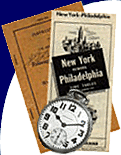

| home | articles | briefs | classifieds | flimsies | interchange |
 |
 |
||||||
|
|||||||
 |
RyPN Briefs October 1, 2006 previous brief ~ return to briefs index ~ next brief Conduit Artifacts at National Capital Trolley Museum One of the unique attributes of street railways in Washington was the extensive use of a conduit system to supply power to the cars. This system was used in the old downtown, generally defined as south of Florida Avenue, an east-west artery. Large cast iron yokes, weighing 350 lbs. each, were spaced every five feet beneath the street. The yokes supported the running rails, as well as the surface "slot" rails in the center of the track. There was a concrete conduit, or trough, located beneath the slot that contained two conductor rails that supplied power to the cars. A large plow was suspended from the truck frame on the streetcar. The plow had two shoes that made contact with the conductor rails.
For many years, the goal of acquiring one or more yokes proved difficult for members at the National Capital Trolley Museum. There was early success in the 1970s with the acquisition of a complete turnout from the intersection of 6th Street and Pennsylvania Avenue. The running rails and slot rails were removed in pieces, and the resulting "kit" is stored at the Museum. Unfortunately, no yokes were obtained when the switch was removed. Occasionally a contractor working in the city would call the Museum to offer track parts. However these usually turned out to be bits and pieces of scrap rail, damaged when the contractor was excavating the tracks. Working on a tight deadline, the contractors used jack hammers to dig out the rail. In doing so, the brittle yokes would crack into pieces that were not of much use as future interpretive objects.
Success finally came in the late 1990s when a contractor working at 4th and T Street, in the northeast section of the city, uncovered and removed from the street a large concrete "box" that completely encased two yokes and a section of the running and slot rails. It was assumed that the box was a vault that collected water draining from the slot as part of the storm drain system. There are no transit company records to tell us otherwise. For the grand sum of $600, the contractor carefully cleared away the concrete walls of the vault and delivered the piece intact to the Museum.
Close inspection revealed several cracks in the yokes, and the slot rail was welded closed at some point using a piece of rebar. Future plans call for the piece to be installed sitting upright in a new exhibit hall. The Museum owns several plows, and has the remaining trucks from CTCo 1053. With careful planning, the truck may someday sit again on street rails and carry a plow to demonstrate Washington's conduit system. |
|||
Copyright © 1998 thru 2025, all rights reserved, contents may not be used without permission. |